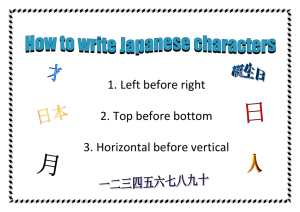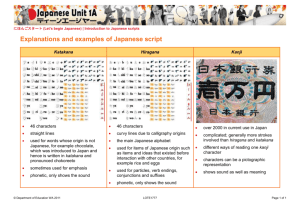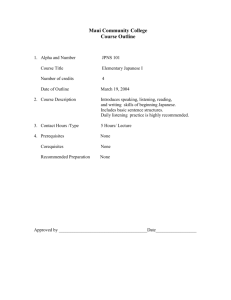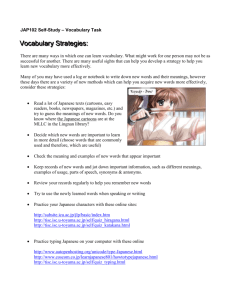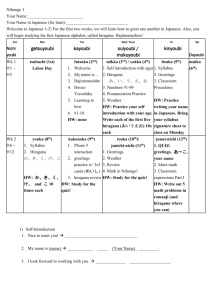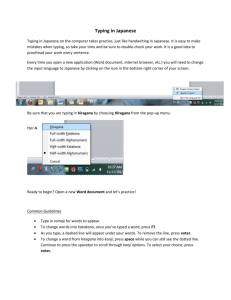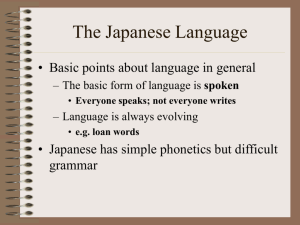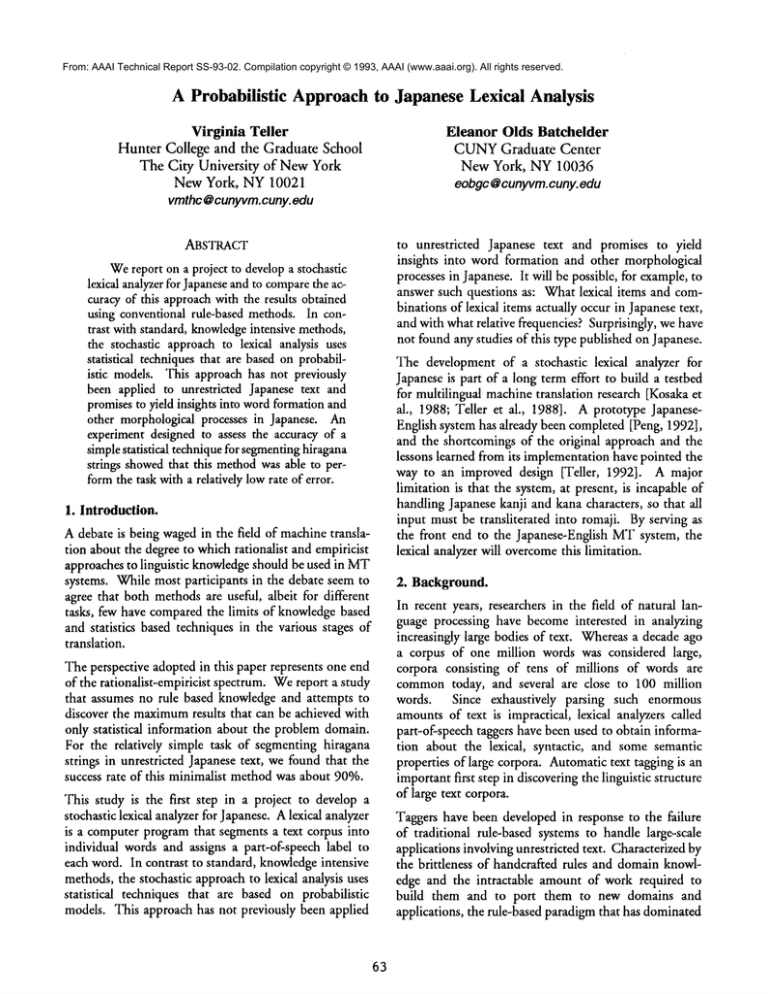
From: AAAI Technical Report SS-93-02. Compilation copyright © 1993, AAAI (www.aaai.org). All rights reserved.
A ProbabiUstic Approachto Japanese Lexical Analysis
Virginia Teller
Hunter College and the Graduate School
The City University of NewYork
New York, NY 10021
vmthc @cunyvm.cuny.edu
Eleanor Olds Batehelder
CUNYGraduate Center
New York, NY 10036
eobgc@cunyvm,cuny. edu
to unrestricted Japanese text and promises to yield
insights into word formation and other morphological
processesin Japanese.It will be possible, for example,to
answer such questions as: Whatlexical items and combinations of lexical itemsactually occur in Japanesetext,
and with what relative frequencies? Surprisingly, wehave
not found any studies of this type publishedon Japanese.
ABSTRACT
Wereport on a project to developa stochastic
lexical analyzerfor Japaneseandto compare
the accuracyof this approachwith the results obtained
using conventional rule-based methods.In contrast with standard, knowledge
intensive methods,
the stochastic approachto lexical analysis uses
statistical techniquesthat are basedon probabilistic models. This approach has not previously
been applied to unrestricted Japanese text and
promisesto yield insights into wordformationand
other morphologicalprocesses in Japanese. An
experimentdesignedto assess the accuracy of a
simplestatistical techniquefor segmenting
hiragana
strings showedthat this methodwasable to performthe task with a relatively lowrate of error.
1. Introduction.
A debate is being wagedin the field of machinetranslation about the degree to whichrationalist and empiricist
approachesto linguistic knowledgeshould be used in MT
systems. Whilemost participants in the debate seem to
agree that both methodsare useful, albeit for different
tasks, few have comparedthe limits of knowledgebased
and statistics based techniques in the various stages of
translation.
Theperspective adoptedin this paper represents one end
of the rationalist-empiricist spectrum.Wereport a study
that assumes no rule based knowledgeand attempts to
discover the maximum
results that can be achieved with
only statistical information about the problemdomain.
For the relatively simple task of segmentinghiragana
strings in unrestricted Japanesetext, wefound that the
success rate of this minimalist methodwas about 90%.
This study is the first step in a project to develop a
stochastic lexical analyzerfor Japanese.Alexical analyzer
is a computerprogramthat segmentsa text corpus into
individual wordsand assigns a part-of-speech label to
each word. In contrast to standard, knowledgeintensive
methods,the stochastic approachto lexical analysis uses
statistical techniques that are based on probabilistic
models. This approach has not previously been applied
63
The developmentof a stochastic lexical analyzer for
Japaneseis part of a long term effort to build a testbed
for multilingual machinetranslation research [Kosakaet
al., 1988; Teller et al., 1988]. A prototype JapaneseEnglish system has already been completed[Peng, 1992],
and the shortcomings of the original approach and the
lessons learned from its implementationhavepointed the
way to an improved design [Teller, 1992]. A major
limitation is that the system, at present, is incapableof
handling Japanesekanji and kana characters, so that all
input must be transliterated into romaji. By serving as
the front end to the Japanese-English MTsystem, the
lexical analyzerwill overcome
this limitation.
2. Background.
In recent years, researchers in the field of natural language processing have becomeinterested in analyzing
increasingly large bodies of text. Whereasa decade ago
a corpus of one million words was considered large,
corpora consisting of tens of millions of words are
commontoday, and several are close to 100 million
words. Since exhaustively parsing such enormous
amountsof text is impractical, lexical analyzers called
part-of-speech taggers have been used to obtain information about the lexical, syntactic, and some semantic
properties of large corpora. Automatictext tagging is an
importantfirst step in discoveringthe linguistic structure
of large text corpora.
Taggers have been developedin response to the failure
of traditional rule-based systemsto handle large-scale
applications involvingunrestricted text. Characterizedby
the brittleness of handcrafted rules and domainknowledge and the intractable amountof work required to
build them and to port them to new domains and
applications, the rule-based paradigmthat has dominated
NLPand artificial intelligence in general has comeunder
close scrutiny. Taggers are one exampleof a class of
alternative approaches,often referred to as "corpusbased"
or "examplebased" techniques, that use statistics rather
than rules as the basis for NLPsystems.
Part-of-speech tagging, per se, is a well understood
problem. Context is used to assign parts of speech to
words, and Markovmodels form the foundation of the
method. The trigram model assumes that each tag
dependssolely on the preceding two tags, so the likelihoodof a particular tag is predicted on the basis of the
two previous tags. This widely used modelcan be stated
informally as the followingconditional probability:
Whatis the probability of tag t for wordw, given
tag t-1 for wordw-1and tag t-2 for word w-2?
Atagger usually assigns a single mostlikely tag to each
wordin the corpus.
Markovmodelsrequire training in order to computethe
probabilities for tag sequences and for words in the
lexicon. Cutting et al. [1992]describe a supervisedbootstrap procedure that uses a tagged training corpus to
build the trigram model.First, a relatively small amount
of text is manuallytagged and used to train a partially
accurate model. The model is then used to tag more
text, whichis manuallycorrected and used, in turn, to
retrain the model.
After training, the performanceof a tagger on a test
corpus depends on a numberof factors, including the
numberof tags and the amountof training data. Meteer
et al. [1991]report that the error rate for a trigram model
with 47 tags increased only from 3.3%to 3.87%when
the size of the training corpus was reduced from one
million wordsto 64,000 words. A robust tagger should
routinely tag 96%to 97%of new text accurately, even
whenfaced with unknownwords.
A majordecision in the designof a tagger is to determine
exactly what will count as a word, and whentwo sequences of characters are instances of the samewordor different words [Brown et al., 1992]. This may sound
trivial -- after all, wordsare delimitedby spaces-- but
it is a problemthat has plaguedlinguists for decades.For
example, is shouldn’t one word or two? Is shouldn’t
different fromshouMnot?. If hyphenatedformslike rulebased and Baum-Welch
(as in Baum-Welch
algorithm) are
to count as two words, then what about vis-a-vis?
Theeffects of capitalization mustalso be considered, as
the following exampleshows:
Bill, please send the bill. Bill metoday or bill
64
me tomorrow. MayI pay in May?
In the first sentence Bill is a proper nounand bill is a
common
noun. In the second sentence Bill and bill are
the same -- both are verbs, while in the third sentence
Mayand Mayare different -- one is a modal and the
other a proper noun.
These problems are compoundedin Japanese because,
unlike English, sentencesare written as continuousstrings
of characters without spaces betweenwords. As a result,
decisions about word boundaries are all the more difficult, and lexical analysis plays an important preprocessing role in all Japanese natural languagesystems.
Before text can be parsed, a lexical analyzer must segment the stream of input characters comprising each
sentence.
Japaneselexical analyzers typically segmentsentencesin
two major steps, first dividing each sentence into major
phrases called bunsetsu composedof a content word and
accompanying function words (e.g. noun+particle,
verb+endings),and then discovering the individual words
within each phrase. Algorithms based on the longest
match principle perform the bulk of the work [Kawada,
1990]. To extract a bunsetsu structure from an input
string, the systemfirst proposesthe longest candidatethat
matchesa dictionary entry and then checks whether the
result agrees with the rules for bunsetsucomposition.If
the check fails, the system backtracks, proposesanother
shorter word, and checks the composition rules again.
This process is repeateduntil the sentenceis dividedinto
the least numberof bunsetsuconsistent with its structure
[Ishizaki et al., 1989].
Maruyama
et al. [1988] describe a sentence analyzer that
consists of five stages, each of whichexploits a distinct
kind of knowledgethat is stored in the form of a set of
rules or a table. Thefive stages are: segmentationby (1)
character type, (2) character sequence,and (3) a longest
matchingalgorithm; (4) a bottom-upparallel algorithm
if stage 3 fails; and (5) compound-word
composition.
The first three lines in the romaji examplebelow illustrates what the procedure must accomplish:
sisutemugabunobunkaisuru.
romaji:
bunsetsu: sisutemuga/buno/bunkaisuru.
words:
sisutemu-ga/bun-o/bunkai-suru.
meaning: system-subj/sentence-obj/analyze-nonpast
translation: A/Thesystemanalyzes a/the sentence,
Ourproject has several purposes: To construct a Japanese lexical analyzerbasedon the statistical techniquesand
Markovmodels used in taggers; to determine if the
success rate achievedwith this methodis comparableto
that obtained with the knowledgebased techniques now
in common
use; and to learn more about word formation
and other morphologicalprocesses in Japaneseby examining the frequencies of wordsand various wordpatterns.
In addition,the lexical analyzerwill serve as the front end
to our Japanese-English machine translation system,
which will makeit possible to process Japanese text
withouttransliterating it into romaji.
3. Project Design.
Themainsteps in building a tagger are:
1. Obtaina suitably large corpusand divide it into a
groupof training sentencesand a groupof test sentences.
2. Decideon the set of tags, preferablyless than 50.
3. Tag 50,000-100,000 words by hand in order to
obtain lexical probabilities for high frequencywords.
4. Usethe results of step 3 to tag the training corpus
(preferably at least 1 million words)automatically, then
correct the tags by hand.
5. Computecontextual probabilities based on the
part-of-speechtags obtainedin step 4.
6. Tag the test corpus automatically to assess the
accuracyof the tagger.
Wehave encountered numerousobstacles in finding a
sizeable corpus of Japanesetext to provide training and
test data and have not yet obtained access to a corpus
sufficient for our purposes. However,wehave located a
Japanese }exical analyzer called JUMAN
that will be
useful in performing benchmarktests. Developed at
Kyoto University, JUMAN
is considered the best segreenter and morphological analyzer available and is
reported to tag with a success rate of about 93%.An
improvedversion of JUMAN
is expected to be released
shortly. The tagger that we construct should at least
equal JUMAN’s
performance if the probabilistic approachis to be viewedas a viable alternative to existing
rule based methods.
Decidingon an appropriate tagset involves balancingthe
trade-off betweena smaller tagset, whichproducesmore
accurate results, and a larger tagset, whichreveals the
linguistic structure of the corpus in greater detail. The
Japanese dictionary in our machinetranslation system
currently lists 33 lexical categories, including some
semanticclasses for nouns. However,a muchsmaller set
of tags wouldbe adequate for the segmentationproblem
alone.
The most time-consumingand laborious task is manually
tagging text. Marcuset al. [1992] comparethe performance of human annotators when they tagged text
entirely by hand and whenthey verified and corrected the
65
output ofan automatic stochastic tagging program.They
found that in correcting modemedianannotation speed
was about twice as fast (20 vs. 40 minutes per 1,000
words); disagreement rates amongannotators are about
half as high (3.5% vs. 7o6); and error rates were also
about half as high (3%vs. 6%).
4. An Experiment.
4.1. Design. As a first step in developinga tagger for
Japanese, weconductedan initial experimentdesignedto
assess the accuracyof a simple statistical technique in
segmentinghiragana strings into words. This measureis
loosely based on the notion of mutualinformation[Brill
et al., 1990; Magerman
& Marcus, 1990]. The strategy
underlying the design was to discover the maximum
results that could be achieved with a minimumof
computational(and human)effort.
The corpus for this study consisted of 216 short texts
averaging 6-7 lines each and totaling 1457 lines and
98,048 bytes of data. (Japanese characters occupytwo
bytes each.) Fourdifferent types of characters appear in
Japanese text: kanji characters borrowedmore than a
millennium ago from Chinese; two kana syllabaries,
hiragana and katakana; and romaji, consisting of Roman
alphabetic and Arabicnumeralcharacters. Thesyllabaries
contain equivalent sets of around 80 characters each.
Hiraganais used for Japanesewordsandinflections, while
katakana is used for words borrowed from foreign
languagesand for other special purposes.
Duringthe first stage of processing, a programscans an
input file of Japanesetext andidentifies strings of oneor
morehiragana characters. For each such string it computes a bigram frequency count based on the type of
character that immediately precedes and follows each
hiragana. Five different character types are distinguished:
[h] hiragana
[K] kanji
[k] katakana
[P] punctuation
[R] romaji
Eachhiraganacharacter is tallied twice -- onceas a pair
with its preceding hiragana character or other character
type and once as a pair with the followingcharacter.
Theoutput of this stage of processingis a 90 x 90 bigram
frequency array. The rows and columns in the array
include 83 hiraganacharacters and 4 other character types
plus an end count, an error count, and a row or column
total. The end count is tallied wheneverthe hiragana
character is the last in a string (the pair h + {K,k,P,R}),
and the error count has not been needed so far. The
samplecorpus produceda sparse matrix with a total of
20,012 pairs tallied in 802 of the 8100cells. Table 1
showsa fragmentof this array that clearly reveals three
high frequencyhiraganastrings: kara, a particle; kiru, a
verb form (as in dekiru); and kor¢, a pronoun. Table 2
lists the ten most f~equenthiragana characters together
with an indication of thc special functions in Japanese
that largely accountsfor their high frequencies.
ra
140 3 2
1
ki
43
1
ku
1
ke
7 12
3 2
3
ko
38 12
Thelikelihood of beginninga wordis estimated from the
proportion of all occurrences of the hiragana character
immediatelyfollowing a character that is not kanji or
hiragana:
[{k,P,R}+ 112]/ h2-total.
This measureis not compledMy
convincing, because most
word-beginninghiragana are particles following kanji.
However,these cases cannot automatically be distinguished from other cases (also numerous) where kanji+hiragana represent a single word, so kanji is omitted
from the measure.
Table1
char
%
no
13.10
to
function
particle
6.66
6.60
particle; koto
verb ending
wo
ni
6.48
particle
5.57
particle
ha
5.53
particle
de
5.45
particle
si
5.35
ta
4.35
verb forms
past tense marker
ga
3.61
particle
ru
B. A word boundary is created between two hiragana
characters if the combined
probability of the left character
ending a word and the right one beginning a word is
greater than a probability of the two occurringtogether.
If the end/begin likelihood is equal to or less than the
co-occurrencelikelihood, no cut is made.
The likelihood of ending a word is estimated from the
proportion of all occurrences of the hiragana character
that immediatelyprecedeany non-hiraganacharacter, i.e.
the hiraganaends a hiraganastring:
[hl + {K,k,P,R}]/ hi-total.
The assumption is that no word contains hiragarm
followed by non-hiragana. There are kanji compound
"words",however,that are typically written with the first
part in hiragana to represent a too-difficult kanji; such
compounds
will be divided incorrectly by this method.
ri ru re ro
ka
or romaji characters are assumedto begin a newword.
Thesecases fall into the categoryof "no decision needed."
The likelihood of co-occurrence is estimated from the
product of two percentages:
( [hl+h2] / hi-total ) * ( [hl+h2]/ h2-total
This measureis also flaweddueto the existenceof certain
highly frequent combinationsthat are not usually considered to be a single word, e.g. de ha, and others that
are infrequent but undoubtedlya single word, e.g. mono.
Table 2
4.2. Segmentation algorithm. The segmentation
algorithm uses the bigram frequency array previously
computedto divide hiragana sequences in Japanese text
into individual words. For each hiragana character a
decision is madeas to whetherthis hiraganabeginsa new
wordor is a continuation of the preceding one. A blank
betweentwo characters indicates they are part of the same
word, while a ’1’ indicates a word boundary. The algorithmworksas follows:
A. Hiraganacharacters that follow katakana,punctuation,
66
12. Decidingwhether to create a word boundarybetween
a kanji character and a following hiragana presents the
greatest difficulty, becausesomekanji-hiraganatransitions
are continuations of the sameword(YO+bu)while others
are not (HON+wo).
Division is based on a comparison
of the frequencyof the hiragana followingkanji and its
frequencyfollowingother non-hiraganacharacters in the
set {k,P,R}. Our reasoning is that the non-kanji cases
cannot be continuations (case A above), while the kanji
cases can be either continuous or discontinuous. Four
casesarise:
1. If this hiragana very rarely appears followingnonkanji characters (h < 0.5%of all hiragana in post-kPR
position), then its occurrencefollowingkanji is assumedto be a continuation of the same word.
2. If this hiraganaappearsafter non-kanjicharacters
significantly more often (> 0.5%) than after kanji
characters, then begin a newword.
3. Conversely,if the post-kanji ratio is greater than
or equal to the post-kPR ratio, and the post-kPR
ratio is less than 1%, then consider the hiragana a
continuation.
4. Otherwise, if tile probability of this hiragana
beginninga wordis greater than the probability that
it is a continuation,then separate.
4.3 Results. In the experiment, 90%of the corpus was
used to build the bigramfrequency table, and the segmentation algorithm was tested on the remaining 10%.
Ananalysis of the output revealed that 90.7%of the 697
strings in the test corpus weresegmentedcorrectly, and
9.3% were segmented incorrectly. A breakdownof the
results is shownin Table 3. Examplesof correct and
incorrect segmentationappear in "[’able 4, whereupper
case denoteskanji characters. Thelowerpart of the table
gives an improved segmentation for the incorrectly
segmentedstrings.
algorithm is not surprising, becauseresearch has shown
[Nagao,1984] that character type information alone can
be used to segment Japanese into bunsetsu units with
about 84%accuracy. Our methodfor hiragana strings
improveson this result, but wehave purposely avoided
dealing with the problems associated with segmenting
strings of kanji. Recent work by Fujisaki and others
[Fujisaki et al, 1991; Nishino& Fujisaki, 1988; Takeda
& Fujisaki, 1987], however, has demonstrated that ngrammodelingtechniques can be successfully applied to
these moredifficult cases as well.
The methodwe have used to segment hiragana strings
does not depend on a lexicon or even on any formal
notion of what constitutes a wordin Japanese. Relying
solely on character type informationand bigramfrequencies, the algorithm makesa decision as to whether to
create a word boundaryor not. Moreover,we found that
adding a log function to the computation, whichmakes
the measure equivalent to the mutual information
statistic, did not significantly changethe results. This
suggests that the extra work involved in computing
mutual information maynot be neededfor the relatively
simple problemof segmentinghiragana strings.
correct
category
no decisionneeded:{k,P,R} + h
segmented
correctly
segmented
incorrectly
I KAriru I koto I ga I dekiru I to I iul
I HANAseruI you I ni I natta I
strings
110
522
I wo I niranda I
59
6
questionable
decisions
total
incorrect
I OOkiI i I to I i I wareteiru I
697
I wotsukuruI to I to I moI ni
better
Table 3
The algorithm performed well in some respects and
poorly in others. Althoughkanji compound
verbs (kanji
followedby suru) werecorrectly maintainedas a unit, the
treatment of the -teiru/-deiru stative/progressive verb
endingwasinconsistent. The-re form wasleft intact (to
i ru) while the -de version wasincorrectly segmentedas
de I i ru. "[’he particles nado,me, ande werenot separated from preceding kanji, but the wordstome ’together’
and mono’thing’ were divided in the middle. Some
commonadverbial phrases were joined and some were
not. For example,ni tsuite ’concerning’wastreated as a
single wordni tsu i te, but the phrase sude ni ’already’
wasbrokeninto su I de I ni.
The overall excellent performanceof the segmentation
67
I OOkii I to I iwareteiru I
I wo I tsukuru I to I tomoI ni I
Table 4
5. Conclusion.
A potential benefit of a stochastic tagger for Japaneseis
the possibility of increased efficiency. The current
version of JUMAN
is reported to tag one million bytes of
text in approximatelyfifteen minutes. At this rate it
would take about fifty hours to tag the 200-megabyte
Japanese corpus nowbeing used for DARPA’s
TIPSTER
project. Although we cannot estimate the development
time for a stochastic tagger compared to JUMAN
in
terms of computational and humancost, the processing Magerman,D. and M. Marcus. 1990. Parsing a natural
languageusing mutualinformation statistics. Proceedtime couldbe significantly less.
ings of the NationalConference
on Artificial Intelligence,
Thetrue challengeof this project, however,lies both in
pp. 984-989.
the attempt to do somethingthat hasn’t been done before
-- namely,build a stochastic lexical analyzerfor Japanese Marcus, M., B. Santorini and D. Magerman.1992. First
steps towards an annotated database of American
-- and in the promise of tantalizing discoveries about
word formation and other morphological processes in
English. Department of Computer and Information
Science, University of Pennsylvania. Unpublished
Japanese if wesucceed. The outcomewill have an impact
manuscript.
on the design of a Japaneselexicon for machinetranslation.
Maruyama, N., M. Morohasi, S. Umedaand E. Sumita.
1988. A Japanese sentence analyzer. IBMJournal of
ACKNOWLEDGEMENTS
Researchand Development32.238-250.
This work was supported in part by NSFgrants IRI- Meteer, M., R. Schwartz and R. Weischedel. 1991. POST:
8902106 and CDA-9222720and by PSC-CUNY
awards
Usingprobabilities in languageprocessing. Proceedings
6-69283 and 6-63295. Bill Gale and Ted Dunninghave
of the InternationalJoint Conference
on Artificial Intelprovidedvaluableassistance.
ligence, pp. 960-965.
Nagao, M., ed. 1984. Japanese Information Processing.
Tokyo: Denshi Tsuushin Gakkai. (in Japanese)
References
Brill, E., D. Magerman,M. Marcus, and B. Santorini.
1990. Proceedingsof the DARPA
Speech and Natural Nishino, T. and T. Fujisaki. 1988. Probabilistic parsing of
Kanji compoundwords. Journal of the Information
LanguageWorkshop.
ProcessingSociety of Japan29,11. (in Japanese)
Brown, P., S. DellaPietra, V. DellaPietra, J. Laffertyand
R. Mercer.1992. Analysis, statistical transfer, and Peng, P. 1992. Japanese-Englishmachinetranslation using
sublanguage patterns and reversible grammars. New
synthesis in machinetranslation. Proceedingsof the
YorkUniversitydoctoral dissertation. Availableas PROFourth International Conferenceon Theoretical and
TEUSProject Memorandum#45.
Methodological
lssues in MachineTranslation, pp. 83100.
Takeda, K. and T. Fujisaki. 1987. Segmentationof Kanji
primitive wordsby a stochastic method.Journal of the
Cutting, D., J. Kupiec, J. Pedersenand P. Sibun. 1992.
InformationProcessingSociety of Japan28,9. (in JapanA practical part-of-speech tagger. Proceedingsof the
ese)
Third Conferenceon AppliedNaturalLanguage
Processing, pp. 133-140.
Teller, V., M. Kosaka and R. Grishman. 1988. A comparative study of Japanese and English sublanguage
Fujisaki, T., F. Jelinek, J. Cocke,E. Black,and T. Nishipatterns. Proceedingsof the SecondInternational Conno. 1991. A probabilistic parsing methodfor senference
on Theoretical and Methodological Issues in
tence disambiguation. Current Issues in Parsing
Machine
Translation of Natural Languages.
Technology, M. Tomita, ed., pp. 139-152. Boston:
Kluwer Academic.
Teller, V. 1992. Machinetranslation on blackboard principles. Technical Report CS-TR 92-0.3, Computer
Ishizaki, S., Y. Sakamoto,T. Ikeda and H. Isahara. 1989.
Science Department, Hunter College CUNY.
Machinetranslation systems developedby the Electrotechnical Laboratoryof Japan. Future Computing
Systems, Vol. 2, No. 3, pp. 275-291.OxfordUniversity Press and MaruzenCompanyLimited.
Kawada,T. 1990. Inputting Japanese from the keyboard.
Journalof InformationProcessing13.10-14.
Kosaka,M., V. Teller and R. Grishman.1988. A sublanguageapproachto Japanese-Englishmachinetranslation. NewDirections in MachineTranslation, D. Maxwell, K. Schubert & A. Witkam,eds., pp. 109-121.
Dordrecht: Foris.
68

